ISSN ONLINE(2319-8753)PRINT(2347-6710)
ISSN ONLINE(2319-8753)PRINT(2347-6710)
Emre KÖMEK1, Tuncay ÖZSEVGEÇ2, Murat KURT3
|
| Related article at Pubmed, Scholar Google |
Visit for more related articles at International Journal of Innovative Research in Science, Engineering and Technology
In the recent years, an increase is observed in the number of publications on education of highly gifted students in Turkey. There are even new journals that have been introduced in this field. Turkish Superior Intelligence and Education Journal (TUZED), Journal for Studies on Education of Highly Gifted (UYAD), Young Scientist Education and Superior Intelligence Journal (JEYSH) are some of the examples. If we review the literature in our country related with the education of highly gifted students, most of the studies focus on how to identify a highly gifted person and how they should be educated, and it is possible to say that branch education is addressed relatively less. The importance of the science literacy, science education encompassing the subjects on the nature of science cannot be underestimated. Academic dissertations are important resources in the literature as they are based on long-term and indepth studies on the science education of the highly gifted students. The objective of this study carried out with the same purpose aims at reviewing the content of academic dissertations on science education of highly gifted students on our country and revealing the general trend in this field. The present study analyses the content of the postgraduate and doctoral dissertations written in 2001-2013 period on science education of the highly gifted students. The thesis database of the Council of Higher Education (YOK) was reviewed, "highly gifted", "superior intelligence" concepts were written in the database, the thesis results related with the science education (elementary level science education, secondary school physics, chemistry and biology) were included in the study and 25 postgraduate and 4 doctoral dissertations were found. For this purpose 29 dissertations published in the YOK database as full text and abstract were reviewed. The dissertations were written in 2001-2013 and the number is high particularly in 2010. The classification form developed by[1] was used for the review of the dissertations. The findings of the present study show that 25 of them are postgraduate dissertations and 4 of them are doctoral dissertations. In consideration of the methods used in these dissertations, 14 of them were prepared using quantitative method, 9 with combined method and 6 of them were prepared with qualitative method. The distribution of the subject of the dissertations is within a wide range, and the subjects that have been studied the most are the attitudes of students about science and the environment. Other subjects are training of teachers, differentiated physics education, scientific creativity, creative thinking, image of the scientists, different literacies (science and environment) and teachers` opinions. Majority of the samples groups in the studies consist of highly gifted students of 4-8th grades attending to Science and Art Centre (institutions associated by the Ministry of National Education that can be attended by the students for the education of the highly gifted students in our country for additional courses other than those taught at schools) and the remaining part of the sample groups consist of science teachers (Physics, Chemistry and Biology) working in the Science and Art Centres and administrators of the Science and Art Centres. Most of the sample groups consist of 20-80 persons, and others consist of 100-300 persons. The review revealed that majority of the dissertations on science education of the highly gifted students are postgraduate dissertations, the number of doctoral dissertations are lesser in number as the study area isrelatively new in our country, mostly quantitative methods were used in these dissertations and majority of the sample group consists of highly gifted students attending to Science and Art Centre. This study will assist researchers intending to carry out researches on science education of the highly gifted students in determining which fields are required to be addressed in the studies. In addition, it will reveal the general trend of the dissertations prepared in our country on science education of the highly gifted students. Some recommendations are made in the final part of the study for researchers who want to study in this field.
Keywords |
| Highly Gifted, Superior Intelligence, Science Education, Content Analysis |
INTRODUCTION |
| One of the most important criteria indicating the development level of a country is scientific studies related with the education and the driving power of the universities in these studies is inevitable. Scientific dissertations that are longterm studies carried out at universities are very important in terms of steering the education policies and practices [2]. The history of the practices in connection with the highly gifted individuals that are also called overground wealth dates back to Enderun (special Ottoman schools), however, reviews reveal that contemporary practices and scientific studies in this field have some quantitative and qualitative shortages [3]. It would not be wrong to say that dissertations in our country are prepared on education of the highly gifted students only in the recent years. The number of the dissertations written on the education of the highly gifted students increased substantially in the recent a few years with the attraction force of the recent national and international congress. |
| Compiling the studies carried out on a specific field is important in guiding the relevant studies, laying the theoretical foundations of studies and comparing the results of the studies [4]. Therefore, the present study based on the systematic review of the dissertations written on science education of highly gifted students is important with respect to putting forth the general trend and contributing the literature. |
| The reviews on the relevant literature showed that [5],[6],[7],[8].there are reviews related with the science education and only one [9]carried out a study on the education of highly gifted students. However, no review was found on the science education of the highly gifted students. |
| The objective of the present study is to review the content of the dissertations on science education of the highly gifted students. Answers were sought for the following questions in the present study |
| 1. What are the types of the dissertations written in 2001-2003 in connection with the science education of the highly gifted students? |
| 2. How is the distribution of the dissertations written in 2001-2003 in connection with the science education of the highly gifted students based on years? |
| 3. How is the distribution of frequently studied fields in the dissertations written in 2001-2003 in connection with the science education of the highly gifted students? |
| 4. How is the distribution of frequently studied subjects in the dissertations written in 2001-2003 in connection with the science education of the highly gifted students? |
| 5. What are the research methods used in the dissertations written in 2001-2003 in connection with the science education of the highly gifted students? |
| 6. What are the data collection tools used in the dissertations written in 2001-2003 in connection with the science education of the highly gifted students? |
| 7. Which sample groups were used in the dissertations written in 2001-2003 in connection with the science education of the highly gifted students and what were their sizes? |
| 8. What are the data analysis tools frequently used in the dissertations written in 2001-2003 in connection with the science education of the highly gifted students? |
Method |
| Content analysis method was used in this study as it serves the best for the purpose of the study. Content analysis is a scientific method that allows systematic and objective review of verbal, written and other materials[10].Content analysis is a systematic review allowing evaluation of the general trends of the studies in questions and study outcomes in the descriptive dimension [11]. |
Scope and Term of the Study |
| As the first dissertation on science education of the highly gifted students was published in 2011, the scope of the review encompasses the period between the year 2011 and 2013. Dissertations were searched in the thesis database of YOK. The key terms 'highly gifted', 'superior intelligence', 'gifted', 'talented' were written while searching the dissertations in the database, different number of dissertations were found for each term (for example 41 for superior intelligence, 159 for highly gifted) and dissertations on science education were selected among them. In the selection process of the dissertations on science education, decision was made by analysing the criteria such as the main branch, headline and abstract of the dissertations. Full text was found for 17 dissertations out of 28, and it was seen that 11 dissertations either do not have a published form or access is restricted by the authors. Abstracts of the dissertations were reviewed for those without full text and data retrieved from the abstracts were included in the study. |
Data Collection Tool |
| Publication classification form developed by [1]was adapted and revised to this study with the purpose of reviewing the dissertations. Publication classification form consists of seven parts that are identifier, main branch, subject, method of the dissertations, data collection tool, sample group and data analysis method. |
Data Analysis |
| Results are presented as frequency, percentage, graphics and tables upon saving the data obtained through publication classification form. |
II.FINDINGS |
| Findings are analysed based on the research questions. |
Types of Dissertations |
| If we analyse based on the universities where dissertations were published, 5 of them were published by Karadeniz Technical University and it is followed by Gazi University with 4, Inonu University with 3, Bogazici and Anadolu Universities each with 2 dissertations., |
| In consideration of the languages of the dissertations, 26 of them (89.7%) are in Turkish and 3 of them (10.3%) are in English. Two of the dissertations published in English are from Bogazici University and one is from METU (Middle East Technical University (Figure 1). |
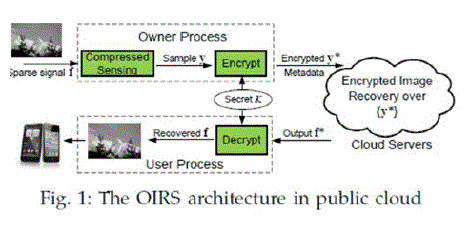 |
| 25 of the dissertations published on science education of the highly gifted students are postgraduate dissertations (86.2%) and 4 of them are doctoral (13.8%) dissertations (Figure 2) |
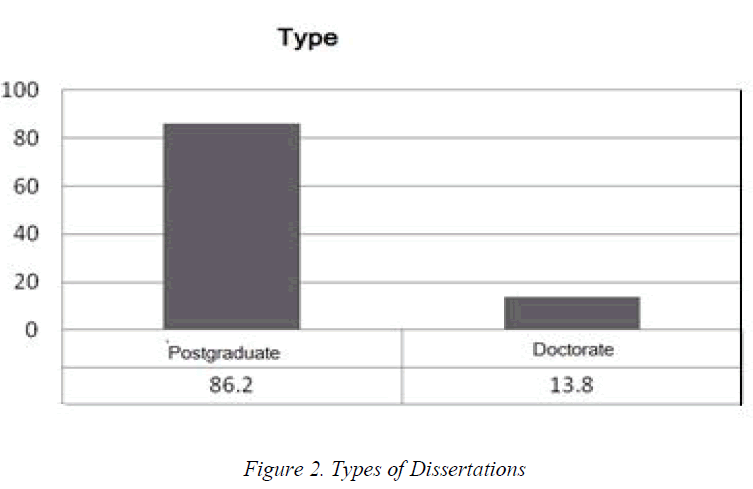 |
Distribution of Dissertations Based on Years |
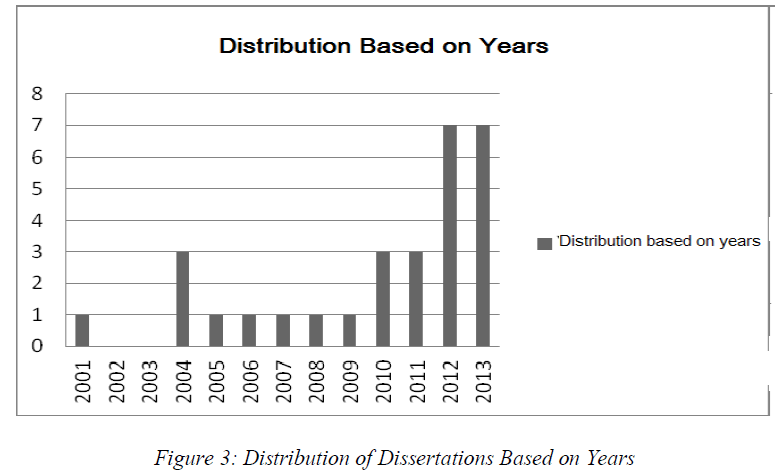 |
| We see that the first study was carried out in 2011 when we analyse the distribution of dissertations on science education of highly gifted students based on years. No studies were carried out until 2004, and 3 studies were carried out in 2004. In addition, the first doctoral dissertation was published in this year. We see that one dissertation was published on each year in the period between 2004 and 2010. We see that the number of studies increases as of the year 2010. There are 3 studies in each of the year 2010 and 2011 and 7 studies in each of the year 2012 and 2013. Approximately 68% of the studies were published in 2010-2013 (Figure 3). |
Field of the Dissertations |
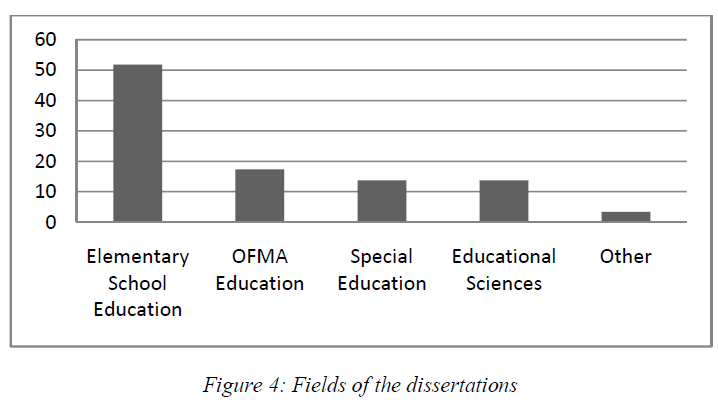 |
| When we analyse the discipline dissertations were published for the science education of highly gifted students; 15 of them were published in the elementary education field (51.7%), 5 of them in Secondary School Science and Mathematics Education (17.3%) and 4 of them were in Special Education and Education Sciences (13.8%) and 1 in Physics engineering field (3.4%). Approximately 73% of the studies are based on science and 27 % of them are based on special education and educational sciences. |
Subject of the Dissertations |
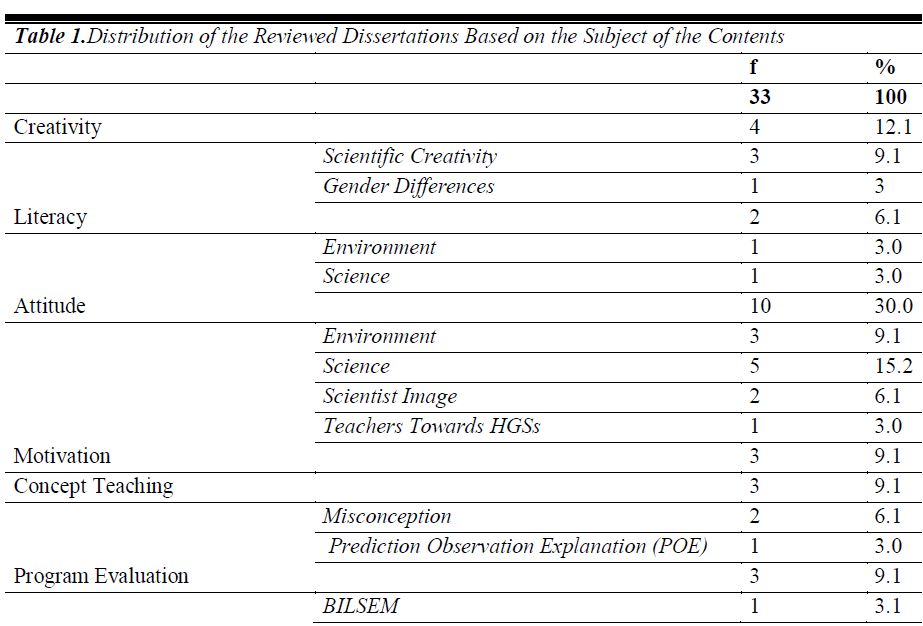 |
 |
| Analysis of the data provided in Table 1 shows that the most frequently addressed subject is attitude (30.0%) in the dissertations on science education of highly gifted students. Attitude towards science, attitude towards environment and attitude of teachers towards members. The most frequently studied subject is creativity (12.1%). Scientific creativity and gender differences in creativity were addressed as in the creativity related dissertations. Creativity is followed by concept teaching (misconception and POE) (9.1%), program evaluation (BILSEM, Beyazit Ford Otosanand Science and technology) (9.1%), Method technique (PDO, PTO) (9.1%), Training of Teachers (In-Service Training) (6.1%), Literacy (Environment and Science) (6.1%) and Motivation. The least studied subjects are physical availabilities (3.1%) (Competence of BILSEM laboratory), identification of science competence (3.1%) and epistemological belief (3.1%). |
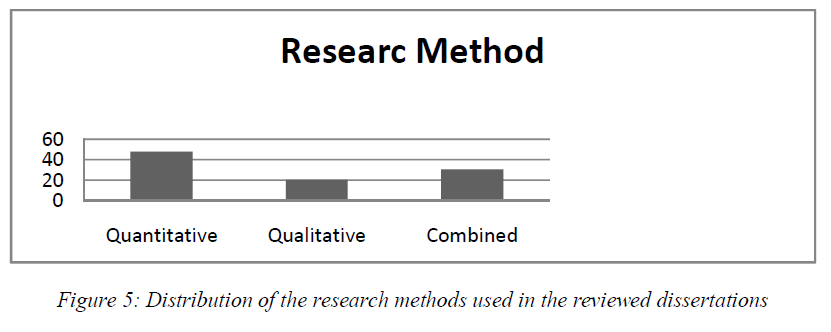 |
| Distribution of the research methods used in the reviewed dissertations is as follows: Quantitative method is 48.3%, Qualitative method is 20.7%, combined method is 31.0%, thus the most frequently used method is quantitative method and the least used method is qualitative method (Figure 5). |
 |
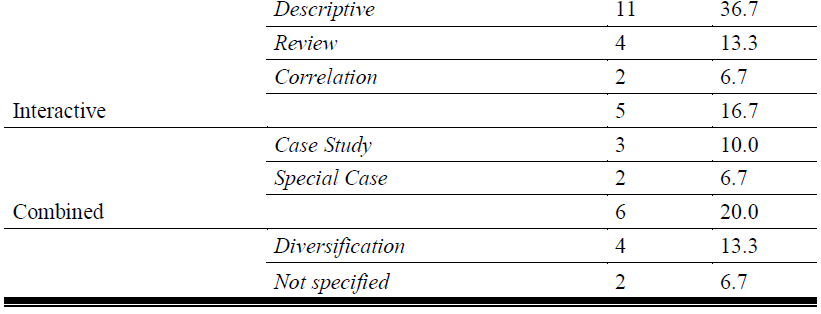 |
| Analysis of the data shown in Table 2 show that the most frequently used research patterns used in the dissertations are non-empirical pattern (descriptive and review) (56.7%), it is followed by combined research pattern (diversification) (20.0%), interactive (case study and special case study) (16.7%) and the least used research pattern is the empirical pattern (6.7%). |
Data Collection Tools of Dissertations |
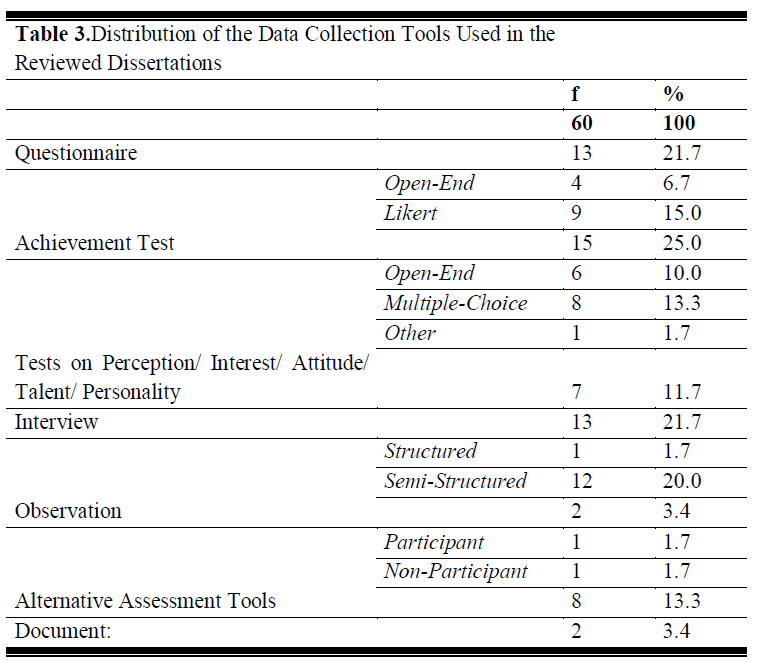 |
| Analysis of the data collection tools used in the dissertations show that the most frequently used tool is achievement test (24.6%) and it is followed by interview method (21.7%) and questionnaire (21.7%), alternative evaluation tools (13.3%), perception/ interest/ attitude/ talent etc. tests (11.7%), observation (3.4%) and document (3.4%). The most frequently used methods are achievement test and interview method and the least used ones are observation and document (Table 3). |
Sample Group of the Dissertations and Their Sizes |
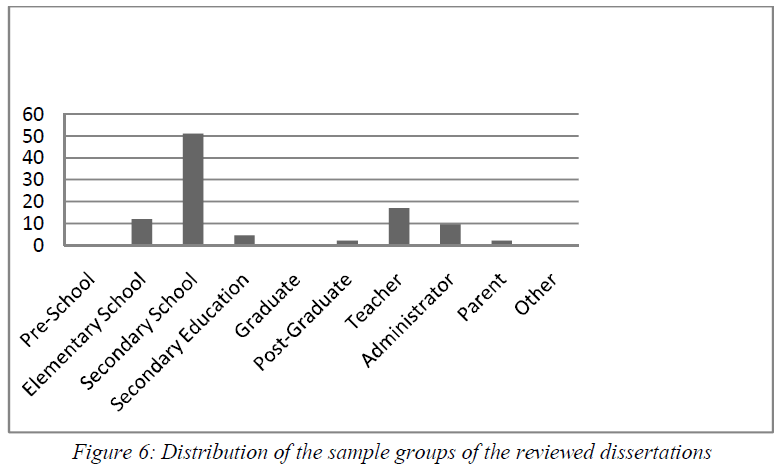 |
| The percentages of the sample groups of the reviewed dissertations are as follows; secondary schools (51.2%), teachers (17.1%), elementary schools (12.2%), administrators (9.8%), secondary education (4.8%), postgraduate (2.4%) and parents (2.4%). As is seen, the most frequently studied sample group is secondary schools and the least studied study groups are postgraduates and parents (Figure 6). |
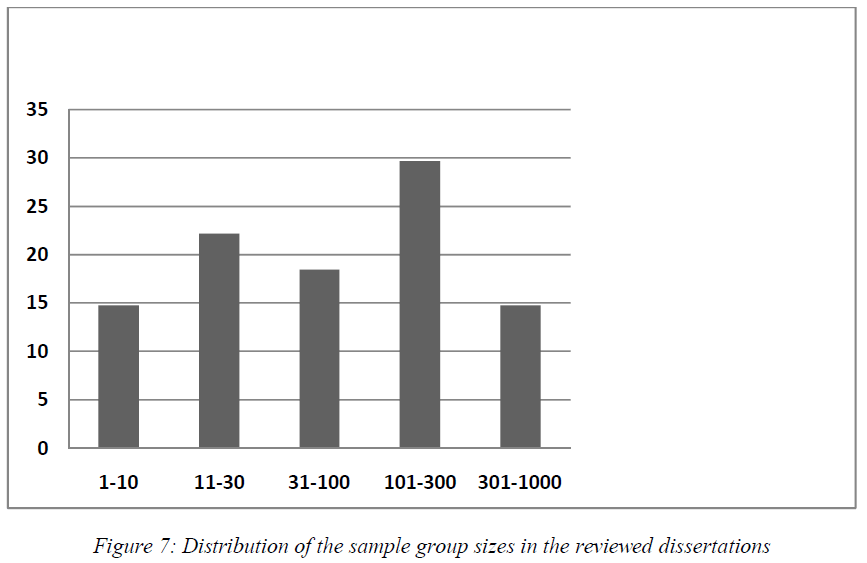 |
| The size of the sample groups in the reviewed dissertations are as follows in percentages: 14.8% for 1-10 and 301-100 individually, 22.2% for 11-30 and 29.7% for 101-300 which has the highest percentage (Figure7). |
Data Analysis Method of the Dissertations |
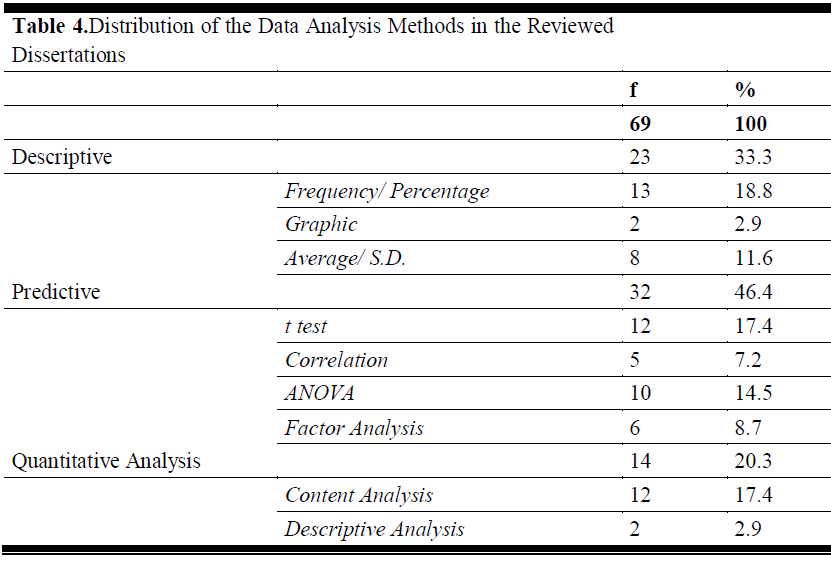 |
| The analysis of the data provided in Table 4 shows that the most frequently used data analysis method is predictive statistics (t-test, ANOVA correlation, factor analysis) with 46.4%, and it is followed by descriptive statistics (Frequency/ Percentage/ Average/ Standard deflection/ Graphic) with 33.3% and quantitative analysis (content and descriptive) with 20.3% which is the least used analysis method. |
II.DISCUSSION AND RECOMMENDATIONS |
| Dissertations on science education of highly gifted students were reviewed in the present study. In the review process, identification information, field, subject, publication language, type, method, sample group, data collection, tool, data analysis methods of the dissertations were analysed in the review process and answers were sought for 8 research questions in total. The findings on each research question are discussed in each part and various recommendations are made. As is seen in Figure 1 and Figure 2, majority of the dissertations on science education of highly gifted students were published in Turkish (89.7%) and very small number of them were published in English (10.3%). The reason for that is the fact that the number of universities providing education in English is very less. Among 2 studies in English, 1 of them was from Bogazici University and one of them was from METU. 25 dissertations written in Turkish are from various universities in our country (If we analyse based on the universities that published the dissertations, Karadeniz Technical University is the highest with 5 dissertations and it is followed by Gazi University with 4, Bogazici, Anadolu and Inonu Universities each with 2). |
| Figure 3 providing the distribution of the dissertations on science education of highly gifted students based on years shows that approximately 68% of the dissertations were published in 2010-2013. We see that the first dissertation was published in 2001 and no study was carried out until the year 2004. There are 3 studies in 2004, one studies on each year between 2005 and 2009, 3 studies on each year between 2010 and 2011 and 7 studies in each of the year 2012 and 2013. Science and Art Centres (BILSEM) were established in our country in 1993 as a concrete step towards the education of highly gifted students and they started education-teaching activities in 1994 in 5 different cities. Dissertations on education of highly gifted students mostly address psychological approaches, identification processes [9]and education in a specific field was addressed at a later period. We see that the number of studies increased gradually between the year 2004 and 2013, and it is associated with the increase in the number of BILSEMs, their expansion to all cities in our country, the fact that postgraduate study programs were introduced in Istanbul and Anadolu Universities, and the relevant national and international symposiums and congress organized in the recent years. As provided in Table 1 related with the subject of dissertations, the most frequently studied subject is attitude (30.0%) and the attitudes of students towards environment and science and attitudes of teachers towards highly gifted students are addressed in the studies. It is followed by creativity with 12.1%. Creativity was addressed to analyse the scientific creativity which in turn analysed around gender differences. The percentage of concept teaching is 9.1% and misconceptions and Prediction, Observation Explanation method were studied. Program evaluation (9.1%) focused on programs of BILSEMs, programs of Beyazit Ford Otosan School, science and technology programs. Problem based learning, project based learning and content differentiation were addressed with respect to methods and techniques (9.1%). Only in-service training was studied with respect to training of teachers (6.1%) and no studies were found in connection with the pre-service education. Some of the other subjects were science literacy and environment literacy (6.1%), motivation towards learning science (6.1%), identification of giftedness in science (3.1%), competencies of BILSEM laboratories (3.1%) and epistemological belief (3.1%). [7] Analysed general trends in science education in our country. In his study, it was found that studies related with program development are approximately 11% in our country, however, no studies were found in the specified years in connection with the specific program development for highly gifted students in science. The percentage of the attitude is 7% in his study which substantially exceeds the percentage in our study. The reason is the fact that the field is relatively new in our country. |
| As shown in Figure 5 related with the research methods of dissertations, the most frequently used research method is quantitative (48.3%) and the least used method is qualitative (20.7%). This outcome is partially consistent with the study of [1]. In their study, too, quantitative research method is the most frequently used method. However, the least used method is not qualitative method but the combined method. It would not be wrong to say that the challenge in working with the highly gifted students for long periods is the reason of the lesser number in qualitative studies. Among research patterns, descriptive and review patterns are the highest in number (56.7%) and empirical method is the least used method (6.7%). This is also caused by the challenging nature of carrying out studies on highly gifted students and the fact that the field is new in our country. |
| As is seen in Table 3 showing data collection tools of dissertations, questionnaires correspond to 21.7% of the tools, achievement test is 25%, interview is 21.7% and the least used data collection tools are observation and document due to the low number of qualitative studies. |
| Figure 6 on sample group shows that secondary schools (51.2%) are the most frequently studied groups and the least studied groups are parents (2.4%) and postgraduate students (2.4%). Secondary schools are the most frequently studied groups because BILSEMs mainly focus on secondary school students. As sample groups, 68.3% of them studied students, 17.1% studied teachers and 9.8% studied administrators. The reason for secondary education to hold a low percentage (4.9%) is the fact that Turkish Education Foundation InancTurkes Private School (TEVITOL) is the only high school for highly gifted students. The sample group mentioned in the study as postgraduate group consists of academicians of the Istanbul University, Department for Education of Students with Superior Intelligence who work in the USA. In consideration of the sample group size, Figure 7 shows that the distribution if 55.5% for 1-100, 29.7% for 101-300 and 14.8% for 301-100, and the reason of the high percentage for 1-100 is the fact that most cities have only one BILSEM and the number of students is relatively low when compared with the number of students in public education. |
| Table 4 related with the data analysis methods of the dissertations shows that descriptive statistics is 33.3%, predictive statistics if 46.4% and qualitative analysis is 20.3%, thus it shows that majority of the studies use quantitative study methods and it is in parallel with the low number of qualitative research methods. |
| Recommendations: |
| ïÃâ÷ Doctoral dissertations can be written in this field as the number of doctoral dissertations on science education of highly-gifted students is low when compared with the number of postgraduate dissertations. |
| ïÃâ÷ Main branches of the dissertations is mostly science education (elementary level science education and secondary level science and mathematics education). Studies can be carried out in other fields. |
| ïÃâ÷ Long-term specific studies based on qualitative research method can be carried out in this field. |
| ïÃâ÷ Observation was used in limited number of studies as data collection tool. As observation is an important data collection tool in collecting the data related with highly-gifted students, observation can also be used in dissertations. |
| ïÃâ÷ Pre-school study groups can be focused for early identification of the science talent. |
| ïÃâ÷ Studies can be carried out on the secondary education level students as they were studied very little as study group. |
References |
|